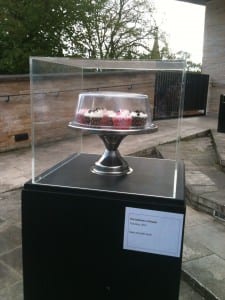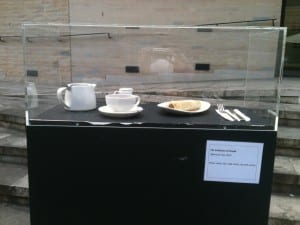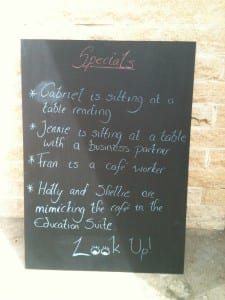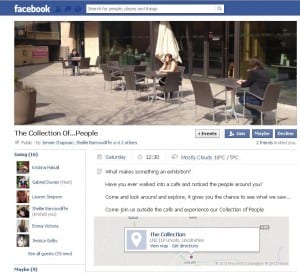Our final performance is an exhibition of the least exhibited part of the gallery; the cafe.
Through our observations and listening to conversations we realize that there is a lot to look at and listen to whilst in a cafe especially in an art gallery. We decided on exhibiting these features.
We will have a cake stand
A tea set
and a specials board
All of these familiar cafe features will be displayed in a professional manner much like the gallery would. We will use cases from the gallery itself to house some of our exhibits and we are placing barriers to keep people away from the exhibits, we did this to make our gallery profession much like the actual gallery itself. Another way which we will do this is to put up placards that explained what each exhibit was.
‘Museum display has attracted the interest of performance studies scholars because it forces engagement with the important issues about representing cultures and identities and the social production of meaning in time and space’ (Allain, 2006, pg 175) I think this quote helps to define our attraction to the way in which museums display their works. It ‘forces engagement’ because our piece is and instillation like an exhibit you would expect to find in a gallery people feel the need to look at things like they would a art gallery. I hope that this is the case and our audience feel compelled to explore the space and interpret our exhibits for themselves.
We as performers are presenting what we have seen and heard in the cafe but on a more emphasised scale; causing people to notice things they might not normally.
We will have two tables set up by the windows to frame them and to reflect real life within the cafe. The two members of our group at this table were reciting things to themselves that we had heard people say in conversation during our observations. I feel that this will grab people’s attention as the wander by and allow them to make their own observations.
We are going to have a greeter; this member of our group will stand on a platform and address audience members as they come past. They will offer up phrases that could be heard by a member of the staff within the cafe, such as; How can I help?, Would you like ice with that?, which table are you sitting at? And thank you, we look forward to seeing you again soon.
We will then have two members of the group in a glass window of the adjoining building to the cafe; this is another way of framing our observations as they were in effectively a glass box. These two were mimicking much like children would a pair of adults. They are going to act and be dressed as adults but they showed the idea of childlike mimicry by using a Childs table set and tea set.
We are going to use verbatim strongly in our piece as we feel it has a strong connection with what galleries do. They exhibit people’s ideas and work. Therefore we are going to display through verbatim the general public’s thoughts and feelings.
‘ “Verbatim theatre” The term…. refers to a form of theatre which places interviews with people at the heart of its process and product’ (Headicke, 2009, pg 115) within our performance we have used aspects of verbatim, we gathered our information by listening to conversations and observing peoples behaviours as we felt it was the best way to get peoples true feelings rather than ask people to participate in interviews as this could mess with the information that we found.
Our performance is taking place at The Collection Gallery on Danes Terrace in Lincoln. We are going to be presenting our gallery between 12 and 2 on Saturday the 4th of May. Feel free to come along and experience our exhibition.
Allain, Paul and Jen Harvie (2006) The Routledge Companion to Theatre and Performance, New York: Routledge
Headicke, Susan C. et al (2009) Political Performances (Theory and Practices), Netherlands: Editions Rodopi B.V.



